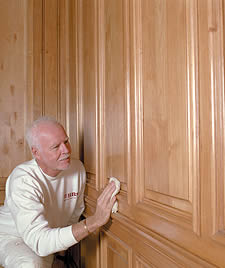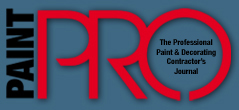
Wood Finishes, Lacquer, Shellac
Clear wood finishes. Separating clear finishes into families, based on how the products cure, can make understanding this category of coating products a lot easier.
by Susan M. Brimo-Cox
of clear wood finishes can be a challenge, even for painting professionals. Sometimes terms are used interchangeably or a brand name may be used incorrectly as a synonym for a type of finish. It is no wonder that making the correct selection for the task at hand can be confusing.
Separating clear finishes into “families,” based on how the products cure, can make understanding this category of coating products a lot easier.
“Evaporative” finishes cure when their solvents evaporate. Shellacs and lacquers fall into this group.
Shellac uses a natural resin — a secretion from the lac bug — which is dissolved in alcohol. Lacquer, a solvent-based product commonly made with nitrocellulose, has overtaken shellac as the product of choice in this family. Original equipment manufacturers (such as cabinet and furniture manufacturers), paint contractors and antique restoration/refinishing professionals are the primary consumers of these finishes.  Both shellac and lacquer dry very quickly and are excellent when dust may be a problem. Both develop a tough coating on wood, though lacquer is more durable than shellac. Because the molecules are small, light can reach through these finishes to give “depth” to wood. And because these products are solvent-based, when applying multiple coats it is not necessary to sand between coats. For example, when you apply numerous coats of lacquer, each new coat partially dissolves the previous coat and chemically bonds with it. This characteristic also makes these finishes easy to repair. Both shellac and lacquer dry very quickly and are excellent when dust may be a problem. Both develop a tough coating on wood, though lacquer is more durable than shellac. Because the molecules are small, light can reach through these finishes to give “depth” to wood. And because these products are solvent-based, when applying multiple coats it is not necessary to sand between coats. For example, when you apply numerous coats of lacquer, each new coat partially dissolves the previous coat and chemically bonds with it. This characteristic also makes these finishes easy to repair.
There are disadvantages with evaporative finishes. Shellac typically has an orange or amber tint and can color wood, but the tint is sometimes chemically bleached out. Shellac also doesn’t have much of a shelf-life. Lacquer is highly flammable and emits dangerous fumes. It also typically needs to be applied with a sprayer, which limits its use; though brushable lacquer products are available. And while lacquer stays clear for a long time, it has a slight tendency to amber over time. For moisture and abrasion resistance, this group is good, but reactive finishes are better.
Varnishes and polyurethanes fall into the “reactive” group family. These finishes cure with a chemical reaction when the liquid finish comes into contact with oxygen.
Varnishes using natural resin from trees have been around for some time — some tracing back to Egyptian times. As varnishes became more refined, so did the formulations. Recipes evolved using various oils, such as linseed or soybean oil, which are cooked and modified with resins to make them harder and dry faster — the more oil used, the softer the finish; the more resin, the harder the finish. Today, synthetic resins help keep the cost of manufacturing down, as natural resins are more expensive.
Polyurethane made its appearance in the consumer market the 1950s with the introduction of Varathane. Polyurethanes are made with a mixture of urethane-alkyd resins. They handle wear and abrasions better than varnishes and have pretty much taken over the varnish market. Nonetheless, both varnishes and polyurethanes are very scratch-resistant and chemical-resistant. Varnishes and polyurethanes protect wood surfaces and are exceptionally good for heavy-use surfaces, such as floors, furniture, cabinetry and molding.
When applying varnishes and polyurethanes you need to watch out for runs and sagging. Also, varnishes — and especially polyurethanes — take a long time to dry. A typical polyurethane takes 24-hours to dry. Professional floor finishers who use oil-based polyurethanes are providing a very durable coating, but they usually have to apply one coat one day, the second coat the next day and the third coat the day after that. If you can’t control dust, this can be a real problem. Also, polyurethanes don’t stick well to other finishes or themselves. Sanding between coats is a must and repairing these finishes is not easy.
Another potential problem is that these finishes yellow over time, though some professionals suggest that the yellowing adds a patina to wood, “warming” certain woods, like oak.
Water-based finishes are “coalescing” finishes because they use both evaporation and a chemical reaction to melt or coalesce together. Don’t let the names fool you, however. Water-based polyurethanes, water-based varnishes and water-based lacquers are not the same as the original products.
The water-based “family” has its own distinctive benefits. Water-based products are water-clear, have low odor and are quick to dry. By using water-based polyurethanes, professional floor finishers can apply several coats in one day (sanding between coats is still required). But while water-based products are moisture-, abrasion- and chemical-resistant, they are not as tough as their oil-based cousins. The obvious soap and water clean up, however, is a plus.
The clear color of water-based polyurethanes is a definite advantage if you’ll be trying to match a finish later on; it will be easier to do if the wood you are trying to match was given a clear water-based finish. Plus, some water-based polyurethanes also can be used as a top coat: over oil or latex-based paint; over lightly stained wood, such as pickling stain; and over wall paper, borders and stenciling.
 There are several disadvantages to using water-based products, however. The curing of water-based finishes is greatly affected by temperature and humidity. They tend to bubble when you brush them and the water will tend to raise the grain of wood far more than any solvent-based product will. And be sure to use sand paper — not steel wool — when sanding water-based products. Steel wool fibers can rust; something you don’t want in the finish. There are several disadvantages to using water-based products, however. The curing of water-based finishes is greatly affected by temperature and humidity. They tend to bubble when you brush them and the water will tend to raise the grain of wood far more than any solvent-based product will. And be sure to use sand paper — not steel wool — when sanding water-based products. Steel wool fibers can rust; something you don’t want in the finish.
When deciding which clear wood finish product to use, carefully consider all aspects of the project. How important is durability? Often, this is the primary aspect driving the decision.
What equipment will you use to apply the finish? If you can use spray equipment, lacquer or water-based products may deliver what you need. However, keep in mind that water-based products may clog the sprayer and also may tend to dry before the sprayer pushes the product onto the surface. If you have to brush on the finish, then oil-based varnish/polyurethanes or water-based products — using natural or synthetic bristles respectively — may be your only options. In difficult areas, such as some molding and trim, where applying a clear wood finish with a brush or sprayer is difficult, oil-based wipe-on or gel polyurethane may come in handy.
What kind of luster do you want? Shellac and lacquer are high gloss. Varnish, polyurethanes and water-based products are available in matte, semi-gloss and gloss.
 Is shelf life important? Products can be purchased “off the shelf,” ready to use. Pre-catalyzed products (lacquer and water-based) offer faster drying times and have a shelf life of about 12 months. With two-part systems (conversion varnishes) you buy two products and mix them before using. But you have to work fast — the pot life of these products is only about an hour. Is shelf life important? Products can be purchased “off the shelf,” ready to use. Pre-catalyzed products (lacquer and water-based) offer faster drying times and have a shelf life of about 12 months. With two-part systems (conversion varnishes) you buy two products and mix them before using. But you have to work fast — the pot life of these products is only about an hour.
Does the product have to provide indoor or outdoor protection? The majority of clear wood finishes are ideal for indoor use. Their use for outdoor applications is another matter because clear finishes lack the protective benefits of pigment. Varnishes and polyurethanes shouldn’t be used for outdoor applications unless they are specifically formulated for exterior use, and then you should limit their use to small surface areas with some protection from the effects of UV light.
There are other clear wood finish products. True oil finishes — either linseed or tung oil — usually enhance the beauty of wood, but do little to protect it. Spar varnish is a flexible varnish product that performs well in marine applications, but offers little scratch resistance. Wax — typically paste wax — also offers little protection. As a group these products would not be on the professional painter’s shopping list.

|

